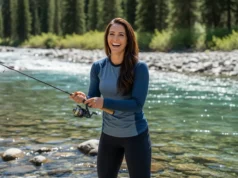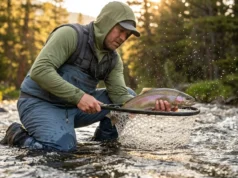In this article
Every serious angler has a story about being cold, wet, and miserable—a day cut short not by a lack of fish, but by a failure of gear. That persistent drip down your neck or the clammy chill from your own sweat isn’t just uncomfortable; it’s a barrier to focus and success. When you’re fighting a shiver, you’re not feeling the subtle take of a walleye in deep water. When you’re squinting through a rain-spattered hood that won’t stay put, you miss the surface boil that gives away a school of feeding stripers. This guide isn’t just a list of jackets; it’s a framework for choosing the right foul-weather gear system for your fishing, ensuring your equipment never becomes the reason you go home early.
We’ll decode the technical jargon that paralyzes so many buying decisions, translating laboratory specs into real-world performance on the water. This comparison review will explore the critical price-performance trade-offs between absolute waterproofness, high breathability, and price—what I call the Dryness Triangle. You’ll learn why a jacket built for an offshore tournament professional is fundamentally different from the ideal shell for a kayak angler or a fly fisherman hiking into a remote stream. We’ll look beyond the fabric to angling-specific features like watertight cuffs and high-speed hoods that separate generic rainwear from purpose-built fishing gear. By the end, you’ll be armed with the confidence to select the perfect rain gear that enhances, rather than hinders, your precious time on the water.
How to Choose the Right Rain Gear: An Expert’s Framework
Making a smart, confident choice begins with understanding what makes a piece of rain gear truly work. It’s not about brand names; it’s about decoding the core attributes that determine whether a jacket will be an asset or a liability. This framework will arm you with the objective knowledge needed to see past the marketing and select gear that performs when you need it most.
Why Do Waterproof and Breathability Ratings Matter?
The heart of any rain gear discussion lies with two numbers that can seem abstract: the waterproof rating and the breathability rating. Understanding them is the first step toward making an informed choice. The Hydrostatic Head (HH) test measures waterproofness by seeing how tall a column of water a fabric can withstand before it leaks, measured in millimeters. A jacket with a 5,000mm rating might keep you dry in a light, passing drizzle, but for a torrential downpour or driving spray, you need to look for ratings of 20,000mm or more. This is the difference between “water-resistant” and being completely waterproof.
The second half of the equation is the Moisture Vapor Transmission Rate (MVTR), which tells you how breathable a fabric is. Measured in grams of water vapor that can pass through a square meter of fabric over 24 hours (g/m²/24h), this rating is your defense against getting soaked from the inside out. If you’re stationary, a lower number is acceptable. But for vigorous activities like hiking or casting, a high MVTR, often supplemented by features like pit zips, is critical to vent the perspiration that would otherwise leave you clammy and cold. This reveals the central engineering challenge: creating a membrane with pores large enough to let water vapor out, but small enough to stop water droplets from getting in. The more waterproof a membrane is, the harder it is to make it breathable. This is why you must also be aware of “wetting out”—a phenomenon where a fabric’s outer water-repellent finish fails, allowing the surface to become saturated. This clogs the membrane’s pores, killing its breathability and making you feel like the jacket is leaking, even when it isn’t. But a jacket is more than just fabric; its quality construction determines its long-term durability and functionality.
| Rating (mm) | Description | Typical Use Case |
|---|---|---|
| 5,000 mm | Light Drizzle. The fabric can resist a light rain for a short period. | Sitting or standing in very light precipitation. |
| 10,000 mm | Moderate Rain. Will keep you dry in a steady, moderate downpour. | General outdoor use with less intense activity. |
| 20,000 mm+ | Torrential Downpour / High Pressure. Considered fully waterproof under extreme conditions and pressure from a backpack or sitting. | Extended periods in heavy rain, such as backpacking or fishing in a downpour. |
What’s the Difference Between 2, 2.5, and 3-Layer Fabrics?
The way a waterproof, breathable membrane is packaged into a garment dictates its comfort, durability, and cost. The most basic construction is the 2-layer shell, where the membrane is bonded to an outer face fabric, with a separate, loose-hanging mesh liner inside. This makes for a cost-effective but often bulkier piece of gear. A step up is the 2.5-layer (2.5L) fabric. Here, the membrane is bonded to a face fabric and protected on the inside by a thin, sprayed-on texture. This makes the garment exceptionally lightweight and packable, perfect for stowing in a pack, but it can feel clammy and is generally less durable.
The gold standard for serious, high-performance gear is the 3-layer shell. This is a “sandwich” where the face fabric, membrane, and an inner liner are all laminated together. This method produces the most durable, breathable, and comfortable garments, but also the most expensive. Finally, there is the non-breathable category of PVC or PU-Coated fabrics, often applied to a poly-cotton base. This material, found in legendary gear like Grundens Herkules 16 Bibs, offers bombproof waterproofing and excellent durability at an affordable price. It’s easy to clean and perfect for facing heavy spray but lacks breathability, which can feel like a personal sauna during any physical activity. This technology is highly refined and is built on principles similar to the materials found in the best fly fishing waders, where the balance of durability and performance is paramount. While the internal construction is vital, the features you can see and touch are what separate a good jacket from a great piece of fishing equipment.
Which Angler-Specific Features Should You Look For?
The true mark of exceptional fishing rain gear is found in the details—features designed with the specific motions of an angler in mind. The single most critical feature is the cuff design. A standard cuff will let water run up your arm when you reach into the water. Look instead for neoprene gaskets or shingled/double cuffs that create a watertight seal.
Next is the hood. A generic hood can inflate like a parachute during high-speed boat runs or block your peripheral vision. A well-designed, 3-point adjustable hood is essential. Pocket layout is another key differentiator. High-set hand-warmer pockets can be reached over waders, and a reinforced plier pocket or a D-ring for your kill switch are signs of thoughtful design. Finally, a fishing jacket is athletic gear. It must allow for a full range of motion. Articulated elbows and gusseted underarms let you cast without the jacket riding up. A proper fit, which can range from athletic cuts to brands offering female-specific fits or big & tall sizing up to 5XL, is crucial for both comfort and performance.
Pro-Tip: When you first try on a jacket, don’t just stand there. Go through the full motion of a double-haul cast or a powerful hookset. If the cuffs slide down your forearms or the hem rides up your back, the fit is wrong for active fishing.
Our Selection Process: How We Built This Guide
Our mission is to build absolute trust by being completely transparent about our rigorous research and curation process. This guide is the result of a comprehensive market analysis, not a sponsored placement. Our only goal is to empower you to make the best choice for your specific needs and budget, ensuring you get the most value and performance for your hard-earned money.
Every product we considered was judged against a standardized set of criteria: raw Waterproof Performance, real-world Breathability, thoughtful Angler-Centric Design, long-term Durability, and overall Fit and Mobility. We started with a long list of over 30 top-rated models. From there, we filtered them down by scrutinizing technical specifications, poring over expert reviews, and analyzing widespread user feedback from anglers who demand quality construction from their gear. The final selections you see here represent the absolute best options for the distinct angling personas we’ve identified.
Please note that if you choose to purchase through the links in this article, we may earn a small commission at no extra cost to you. This is a critical way you can help support our independent research and field testing, allowing us to keep providing this in-depth, unbiased guidance.
The Best Rain Gear for Fishing of 2025: Our Top Recommendations for Every Need
We now present our curated top recommendations. These selections are organized by key user personas, matching proven products to the specific demands of your fishing style.
Our Top Picks for The Tournament Professional
For the hardcore tournament pro who demands absolute, non-negotiable performance, there is no room for compromise. This is gear for high-speed runs during a bass tournament or for offshore fishing in driving spray where failure is not an option. It must be able to withstand years of abuse, because for these anglers, price is secondary to unwavering reliability.
Our Top Picks for The Versatile Specialist
The versatile specialist values a different kind of performance. For fly fishing anglers hiking to remote waters, kayak fishing in tight spaces, and adventurers facing unpredictable weather, weight and packability are paramount. This gear is the definition of packable fishing rain gear, often designed to disappear into a self-stowing pouch until needed.
Our Top Picks for The Practical Workhorse
This is the gear for the budget-conscious angler who demands reliability, ruggedness, and value. From the commercial fishing lifestyle to the weekend warrior on a budget, this category is about finding the best “bang for your buck” without fail. For these users, the absolute, guaranteed waterproofness found in impermeable rain bibs and jackets often trumps high-tech breathability.
Conclusion
The search for the best foul-weather clothing is ultimately a search for balance. Prioritizing the absolute waterproofness of a PVC jacket means sacrificing breathability, a trade-off that works well for some types of fishing but not others. Conversely, prioritizing the exceptional breathability and low weight of an ultralight shell may compromise longevity in rugged environments. The key is to look beyond the fabric specs alone. Angler-centric features like watertight cuffs and a well-designed hood are not gimmicks; they are essential for comfort and functionality during the act of fishing, often making a bigger difference in your day than a few thousand points on a breathability test.
The most important step you can take is to define your primary use case first. A Tournament Professional, Versatile Specialist, and Practical Workhorse have fundamentally different needs on the water. Matching your gear to your specific fishing environment and persona is the surest path to making a smart investment that will pay dividends for seasons to come. So, re-evaluate your current rain gear. Does it truly match your fishing style? Use this guide to identify the single biggest upgrade you can make for more comfortable, more focused, and more successful days on the water.
Pro-Tip: Your rain gear is only as good as its DWR (Durable Water Repellent) coating. When you see water soaking into the fabric instead of beading up, it’s time to restore it. Wash your garment with a specialized tech wash, then use a spray-on or wash-in DWR treatment to bring it back to life. This simple maintenance can drastically extend the life and performance of your gear.
Frequently Asked Questions about Fishing Rain Gear
What is the difference between “waterproof” and “water-resistant”?
Water-resistant gear is designed to handle light drizzle or brief exposure to rain, but it will eventually soak through under sustained precipitation. True waterproof gear, however, is designed with membranes and sealed seams to be impervious during sustained, heavy downpours and driving spray. For serious fishing where staying dry is critical, you should always choose gear that is explicitly rated as “waterproof,” like the Patagonia Torrentshell 3L.
How important is breathability for fishing?
Breathability is absolutely critical for any active angler. It’s the technology that allows the sweat and water vapor your body produces to escape, preventing you from getting wet, clammy, and cold from the inside. Without it, you could be soaked in your own perspiration even if the jacket is perfectly waterproof. For high-exertion activities like hiking to a remote stream or making hundreds of casts, a jacket with high breathability like the Orvis Ultralight is essential for comfort and safety.
Do I really need expensive GORE-TEX rain gear?
No, you don’t always need the most expensive option. While GORE-TEX is rightly considered the benchmark for professional-grade performance and durability, as seen in the Simms ProDry with GORE-TEX Pro, many modern proprietary fabrics offer excellent performance that meets the needs of most anglers. A jacket like the AFTCO Barricade, for example, provides fantastic 3-layer performance with many of the same features as top-tier gear, but at a much lower price point.
How do I care for my rain gear to make it last?
Proper care is key to longevity. The most important step is to periodically clean your gear and refresh its Durable Water Repellent (DWR) coating, which is the finish that makes water bead up and roll off the fabric’s surface. Always follow the manufacturer’s specific instructions for washing. Generally, this involves using a specialized tech wash designed for technical outerwear and then applying a spray-on or wash-in DWR treatment to restore performance, especially when you notice the fabric is starting to “wet out.”
Risk Disclaimer: Fishing, boating, and all related outdoor activities involve inherent risks that can lead to injury. The information provided on Master Fishing Mag is for educational and informational purposes only. While we strive for accuracy, the information, techniques, and advice on gear and safety are not a substitute for your own best judgment, local knowledge, and adherence to official regulations. Fishing regulations, including seasons, size limits, and species restrictions, change frequently and vary by location. Always consult the latest official regulations from your local fish and wildlife agency before heading out. Proper handling of hooks, knives, and other sharp equipment is essential for safety. Furthermore, be aware of local fish consumption advisories. By using this website, you agree that you are solely responsible for your own safety and for complying with all applicable laws. Any reliance you place on our content is strictly at your own risk. Master Fishing Mag and its authors will not be held liable for any injury, damage, or loss sustained in connection with the use of the information herein.
Affiliate Disclosure: We are a participant in the Amazon Services LLC Associates Program, an affiliate advertising program designed to provide a means for us to earn advertising fees by advertising and linking to Amazon.com. As an Amazon Associate, we earn from qualifying purchases. We also participate in other affiliate programs and may receive a commission on products purchased through our links, at no extra cost to you. Additional terms are found in the terms of service.





